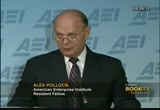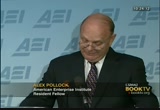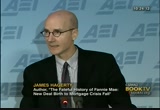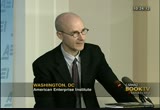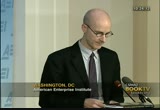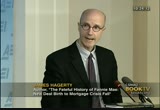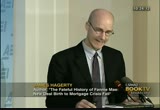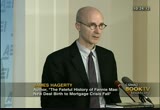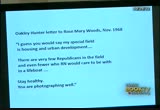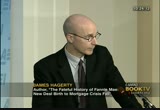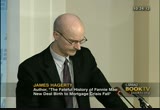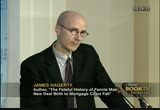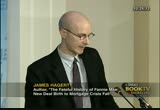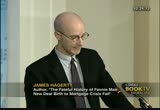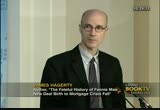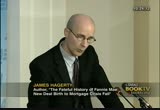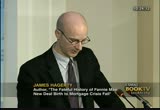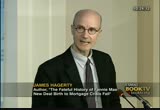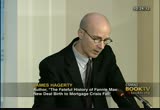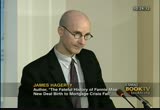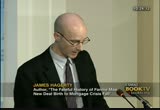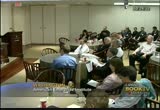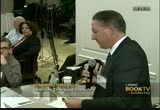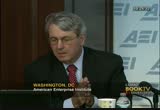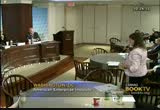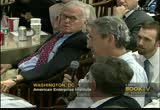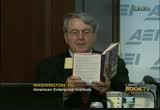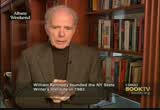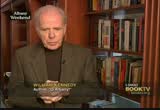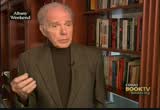tv Book TV CSPAN December 10, 2012 6:30am-8:00am EST
6:59 am
>> he went to harvard. he went to oxford. he became an internet and the nixon white house. both the republicans and democrats wanted him. in the end he chose the democrats. he became a lawyer. he became an investment banker and then he became u.s. budget director under president clinton. people were talking about him as a possible treasury secretary. at fannie mae, raines carried on with the fast growth policies of jim johnson. the clinton administration aide him on. in july 1999, hud secretary
7:00 am
announced an effort he would increase the percentage of their mortgage financing that went to low or moderate income families, to 50% in 2001, from 42% that was set back in 1995. cuomo said these new rules would provide affordable housing for 28.1 million families over the next decade. think about it. cuomo could promise to create 28.1 million homeowners without asking congress to spend a single penny. he simply told fannie and freddie to go out and do it, and they said we would be delighted. you remember how jesus spent the 5000. well, cuomo housed the 28.1 million. rains also have ambitious goals for-profits. he set a goal of doubling earnings to $6.46 per share in five years. is $6.46 was taken very strictly
7:01 am
by his team. this is a peptalk from a senior vice president at fannie mae. find out everyone of you must have $6.46 branded in your brains. you must be able to recite it forwards and backwards. you must have a raging fire in your belly that burns away all doubts. you must live, breathe and dream 6.46. well, then he did meet that earnings goal. the securities and exchange commission found that fannie mae had been a little off on its accounting. raynes said he nothing about any accounting shenanigans. this is raines and the cfo explaining the dubious accounting in congress. so was he to blame? well, just last month he is district judge dismissed the shareholders lawsuit against raines. the judge found no direct
7:02 am
evidence that raines new accounting rules were being violated. though when raines was fired at the end of 2004 there was huge of people at fannie mae. a couple thousand consoles were hired to straighten out the books. a total cost including fines was more than $2 billion, but there was a bigger cost, much bigger. the executives and the regulators spent so much time worrying about accounting that they did not enough time to worry about what was happening in the housing market. housing prices were soaring to crazy levels come even for houses like this. everyone was refinancing mortgages, lending standards became incredibly lax, and just about everybody thought they could make a killing on real estate. even the playmate of the month from may 2005, who informed readers of playboy that she was giving up the modeling to go into what she called investment type real estate.
7:03 am
well, as one financial magazine later commented, she was moving from one set of inflated asset to another. [laughter] well, amid this very dangerous period than the appointed a new ceo, he was an ex-marine, decorate for dangerous mission in lebanon. now you stepping into another minefield. mudd on his job as cleaning up the accounting, making nice with critics of fannie mae, leading the hud goals for affording -- affordable housing goals which been increased for the under president bush, and competing with wall street because by now, wall street was also crazy about mortgage, especially the riskier kinds, because they were very profitable. wall street was taking away more and more of the business from fannie and freddie. mudd and his colleagues were worried that cheney might become irrelevant. so what should they do?
7:04 am
should they go out and buy the same kind of crazy mortgages that wall street was buying, or should they step back from the market and wait for a new outbreak of sanity? mudd and his colleagues knew that the risks were growing in the housing market. but they underestimated how much worse things could get. they were red-blooded american businessmen. they were out to win the game and take on the stock options. they debated for a while in 2005, and in the end by early 2006 they decided if wall street thought was a good idea to buy lots of high subprime mortgage, if wall street was raking in the dough, well, then he should do so, too. of course, they said we will do it in a responsible way. fannie may this indecision. they they both increase their buying of mortgages at the worst possible moment. just went housing market was starting to collapse. well, by late 2007, early 2008
7:05 am
they were losing large amounts of money. the chinese have bought lots of fannie and freddie the bonds were getting antsy. they kept going up paulson and saying what's up? are you behind fannie and freddie or not? we can hardly tell china to go jump in the south china sea because they were our biggest creditors. so by 2008 the game was over. treasury had to come in and provide huge infusions of money. so far this has cost about $142 billion. fannie and freddie now were under the thumb of the regulator, edward demarco, a no-nonsense fellow, and he promised to shrink them gradually and to reduce the independence of the housing market on them gradually. but meanwhile, we are still relying on fannie and freddie to provide funding for most home mortgages. fannie and freddie and fha in recent years have accounted for around 90% of new u.s. homeland. eventually congress will have to make have to make fundamental decisions about what kind of mortgage market will we have.
7:06 am
should we go back to trusting the free market, or shall we have some kind of government mechanism in place to ensure that to mortgages can always be a portable? i submit that the historical record of the past 70 years suggest that when it comes to housing, congress will have a hard time trusting the market. thank you. [applause] >> great comments. this brings us to our discussants. the first will be tom who has been in the mortgage research business for a mere 35 years. a long-standing critic in government sponsored enterprises and has great perspective on the fateful history which bob is so well chronicled. tom was previously with mortgage guaranty insurance corporation, asset-backed capital research, and wholesale access research and consultancy firm.
7:07 am
tom issued early warnings of the increasing risk at fannie mae, about which he was correct, and, of course, ignored. our second discussing, ed pinto is a former executive vice president and chief credit officer of fannie mae, so he's lived in part of his history. as an aei fellow ed has considered groundbreaking research on the contributions of government housing policy for the mortgage crisis. two of his key research papers were submitted to the financial crisis inquiry commission. he is now developing policy considerations, options including countercyclical mortgage policies, an improved understanding of real estate values with appraisals as steps for rebuilding the housing sector. tom, you are first and we're looking forward to your comments. >> good evening. it's a pleasure to be with all of you. my thanks to alex and ed and aei for sponsoring this forum. it's a pleasure to see bob
7:08 am
again. it's been a couple of years. i have come as alex suggested, i've been a long-standing critic of fannie and freddie. however, i don't come from the right side of the political spectrum. rather, i tend to be a lefty. i wasn't sure if i would get through the door without an alarm going off, but i managed to get up here. my very first job out of graduate school was working for mgic. one of my responsibilities there was to monitor the activities of fannie and freddie. and on a quarterly basis i made a pilgrimage to d.c. to visit the executives at fannie and freddie. my responsibilities was to monitor the programs, their products, their people, and i did that for 11 years. i wrote a newsletter on a weekly basis, i included a portion on fannie and freddie because they were such a key determined of the activity that was going on
7:09 am
in the mortgage market. so it gave me an opportunity having started this in the late '70s, but to really watch the history and to follow the evolution of fannie and freddie. and i didn't really become concerned about any of this until after 1992. and the reason i did was really threefold. i had noticed a dramatic cultural change at fannie mae, after 1992. the attitudes, the access to people really changed fairly dramatically, and it really raised my eyebrows, as well as those of a lot of other people. after i left mgic, i continued to monitor their programs as part of my consultancy and research that i was doing, and i continue to follow all of their programs. and i got progressively more concerned. it was not only the more
7:10 am
conservative elements, but also there were liberals as well that were concerned about what was going on. and i remember distinguished, for example, coming to washington in the summer of 1998 to attend a seminar that ralph nader was sponsoring. he, too, was very much a critic. and so the criticism that was being leveled at fannie mae which really coming from both sides, although admittedly conservatives were more on top of it then the democrats and the liberals. the concern in addition to cultural changes that i saw was a result of changes that were going on inside of fannie mae, and freddie mac to a lesser extent. bob has done a marvelous job of tracing its history and the evolution in the book.
7:11 am
and for me it was something like a trip down memory lane, to read his book. because i kept running into names of people like ray laptop, roger berg, all of the people who are involved in the agency, and running it. one summer i read buchanan's book, james buchanan, the nobel laureate, in economic science, and got turned on to the concept of public choice theory. and that was another alarm bell for me, because it gave me another perspective in which to look at what was going on inside of washington. i thought very much that all of this would get solved because the problems were so immense that it seemed to me that if i would notice this, and i didn't come out of harvard or oxford, certainly the rest of the people
7:12 am
in the industry would be as concerned, or more concerned than i was about this. i knew enough about economics to understand the difference in structure, industry structures, competitive markets as compared to the wobblies and monopolies, and i knew, too, when you had market structures that were in this case a statutory duopoly, pettigrew to a very large weight loss. so in the spring of 1996 i was invited by the mba, and i apologize if my voice on flights, i got out of an airplane and now an half ago in my ears have not yet popped. but in any case i was invited to make a presentation as to the profitability of the marcucci -- mortgage banking industry and how it -- white had for so many consecutive years, the three
7:13 am
prior years, why the industry had feared -- fared so poorly from a profit perspective. that prompted me to do some research. i was very fortunate in that the summer of 1996, prior to this presentation i had an opportunity to read the gao study that came out that spring, as was the hud study and the treasury ports. the more i read, the more alarmed i became so that by the time october rolled around i was fully prepared in order to blast the gses, if you will. the speech of which most of it is there, there still a few tables missing that's been passed out to you, and you can see where my criticisms were. that speech was not particularly well received, except among the people, a lot of people in the industry who felt that absolutely. i mean, many of them thought i was right on in terms of my analysis.
7:14 am
the fannie and freddie people, however, within the first 10 minutes were up and out of their seats and out the door, and went to one last go who was the mba president at the time and complain as to why they would allow someone like me to criticize them. what could i possibly know that would prove to be correct. for several years i was blackballed as a result of that, and the mba, took a more like five or six years before they allowed me to come back and make a presentation. in the interim, within weeks, the research that i've been doing and selling to the industry, i got cut off by both fannie and freddie. big surprise. my partners were not particularly happy about that, but, you know, in retrospect it all worked out. as time passed i became more and more concerned about what was going on, and it led me to write a series of letters to everyone
7:15 am
or anyone that i thought would listen to the take a second look at what was going on. and one of those letters is included among the hand out materials, and that was a letter that was sent in 2000, to alan greenspan. the particular time on that letter was such that it was the first time that greenspan had publicly criticized fannie and freddie, and so i wrote a letter to him commending him on that, and outlining my concerns, most of which were economically based, and asking if he would at least take a look, a closer look at what was going on. i continued to write letters like that over a period of years. in fact, all the way up to september of 2008. one of those letters, a second one that was included was a
7:16 am
letter that he wrote to the hud secretary in 2005, the summer of 2005. our research firm had just completed a study of the nonprime market and the conclusion was almost 50% of loans that were being originated were nonprime loans. these are loans that were low documentation with high ltv's, with no income or asset verification. and it was predicated on that data wrote to the hud secretary and asked him if he would please discontinue championing, and actually cheerleading, homeownership because i thought that we were very close to the edge. we were within a year or so i thought, as indicated in the letter, of a collapse in the mortgage market.
7:17 am
spent one minute. >> okay. having said that, let me get back to the book. i write a monthly book review but i'm looking forward to doing a book review now having read bob's very well read, easy to read concise history, and, in fact, that will be published in the december issue of mortgage banking magazine. with that let me turn it over to ed. >> a.q., alex. thank you for arranging this book session and thank you, bob for actual book i really enjoyed reading it, like alex i learned a lot. the history going all the way back to the beginning but i knew some of the but i've learned lots more. thank you, tom, for all of your help, standing up to fannie and freddie and for your friendship. my task when i read a book that i have some relatively intimate knowledge of is to look at that part that i have that in knowledge and cl compares to
7:18 am
what i know. there's a book that was called good to great, written by jim collins about 10 companies, one of which is fannie mae. and it was talking about fannie mae in the 1980s, the david maxwell era, and i was at fannie mae through 84-89. not taking anything away from what david did during that time period, but if you were to take out any references to fannie mae signal is about fannie mae, and asked me what companies is that chapter about, the last company in the world i would've ever guessed was fannie mae. it just had no relationship to reality. there's another book, all the devils are here, the first chapter is largely about against the 1980s. and i found 20 or 25 mistakes large and small and first 2025 or 30 pages. and so i had to wonder well, what's going on in the rest of
7:19 am
the book that i don't have as much knowledge about. i could say that in reading bob's book, i found no major mistakes. i might've found a date here or there which i could've quibbled about a year. that's it. where he had information that i was unaware of, it all seemed consistent with other information i had, so bob, again, congratulations on the research work. i found his research had a broad range of people he talked to, that was one of the problems with "all the devils are here." look at the footnotes, a very range of people. so the got sort of a one-sided view. so you are reporting -- your reporting instincts and integrity, quality of reporting comes through to me as i read the book. bob talked about jim johnson in that study that was done. so the conclusion was if we don't, don't give up the chart, we have to hug the charter.
7:20 am
went to protect the chart at all cost. jim johnson was one of them came up with a strategy is to the way to do that is affordable housing. because the only regulator, the real regular of fannie mae was congress but it was the only ones who could change the charter. and if you could basically co-op congress and capture them through affordable housing, then you would protect the charter and then you could do all the things from earnings perspectives that they went on to do. y. johnson? a friend of mine had been at fannie in one of the regional office for long times it was very simple. fanny had a near-death expense in the early '80s in interest rate risk, and they risk, and they thought they had sold it through hedging. they had a near-death experience in credit risks, and ed, you change the underlying in 1985. they thought it fixed that. they were left with one risk. political. who do you bring in to deal with political risk?
7:21 am
you bring in a politician, and that described while the qualifications that jim johnson had. i want to spend the rest of the time that i have just focusing on a couple of threads. one was the press release that fannie mae, jim johnson announced in 1994, the trillion dollar commitment. a couple thousand words but they went into great detail about what they're going to do. and then the national homeownership strategy, both which are discussed in bob's book. i started with lenders, this is a statement by a community activist, testimony before the senate banking committee that i think really represents a point in which the challenge was thrown down that brought fannie mae together with community activists and congress to accomplish that but became trillions entrance of dollars of affordable housing lending and the loosening of the underwriting standards but lenders will respond to the most conservative standards unless fannie and freddie are
7:22 am
aggressive and convincing in their efforts to expand and further in their ongoing. i will first focus on freddie aggressively expanding their underwriting, and circle back to lenders. but i would point out this is lenders were conservative. and that had any change the way to do it was through fannie and freddie. step one, 1994, you have a hand out. i'm just going to go through this quickly. fanny bowed to transform, their words, housing finance. it 2000 word press release, commit to transforming the housing finance system, vows the company will provide $1 trillion in targeted let me. goes through, this is before the 28 million commitment. this is now 10 million back in 1994. minorities, immigrants, other underserved areas, and people a special housing needs. reach out to every rancher in
7:23 am
america to provide information it needs to buy a home, break down barriers, arbitrary areas, every american wants get him mortgage will have a lot of fruit and put on the path to get that loan approved. that was one of the drivers for the low doc, no doc years later. eliminate the final know him mortgage application process. much was made of wamu having a slogan like that. fanny had in the press release in 1994. they promise clear and flexible underlying standard. flexible under my standards is another word for loose lending. that's what they mean. affordable housing is another word for cross subsidies. that's what it means. fannie and freddie were famous for the cross subsidy, well documented by occiio and now fhfa. the one that really was probably the worst that really politicize fanny, bob talked about, open 25
7:24 am
partnership offices eventually grew to 50 something that would form long-term partnerships with cities, rural areas, underserved communities. really political offices. that was a huge cultural change that had not existed. notwithstanding the rhetoric and the noble sounding goals, this trillion dollar down payment on transforming housing finance by showing america new way home, the book that jim johnson wrote was really an effort to do a much more straightforward and monday and objective. stop any unwanted and unwelcome changes to charter eye-catching the regulator, congress, and give copious amounts of affordable housing that would've published a. it all worked until the charter was changed on june 30, 2008, a mere weeks before their collapse. the same time, step two, a
7:25 am
national homeownership strategy which brought in the rest of the lenders, and it literally brought everybody in the whole mortgage finance field into the fold. and created a partnership to accomplish financing more affordable and flexible indoor to increase homeownership opportunity. what happened, and you have the charts, anyone into competition with fha, down payments with a. i would only take issue with a little bit of what bob said. these things -- [inaudible] >> down payments went down, excuse me. this was a process that was slow. it gained speed but it went on for many years starting in early 1990s, about 93-94. this chart is inverted. it is actually showing the decline in down payments on subprime, as subprime hadn't tried to compete with what fannie and freddie and what at that you were doing to get had to reduce its down payments. historically subprime that 25%
7:26 am
down payment on purchase loans. this chart starts in 2001. tom had a deep provide commitment showed in 1992 it was 25% down payment. you have debt ratios kept going up and up and. i would point out that this was again a process in place every year. by 2007, over one-third of the gses fully documented loans exceeded 45 total debt ratio which again come provided data that said that was a be loan, a be subprime loan back and 1991. that is how prime change over time due to these efforts. alt-a only sort. it happen relatively early when fannie and freddie or large players in it. the consequences of the misrepresentation on lending well known, liar loans extending happened with credit scores. so back to the quote, lenders will respond to both
7:27 am
conservative standards and less fannie and freddie are aggressive in their efforts to expand narrow underwriting but the result was the housing finance system transformed which was jim johnson and fannie mae school, and that's what we ended up with. thank you. >> thanks a much, ed. we're going to leave a little extra time because i know many of you will want to ask questions, let me give bob a chance. do you have any comments to add at this point for a minute or two? >> thank you very much but i think we should just turn it over to time for people who came here today. >> we'll be glad to take your questions. i will remind you of aei rules. wait for the microphone. you can give it to the young fellow here. >> the first rule is, bird gets the first question. >> only if he behaves himself. tell us your name and your affiliation, and your question,
7:28 am
please. >> longtime fan of both fannie and freddie. not. bob, i thought i heard you said at the end of your remarks that there was an inference, congress, has it approached deal with fannie and freddie, it might have in mind, 70 years of market failure. i was really puzzled by that comment. it seems to me we've had 70 years of government failure and a failure of government policy. and my question for you is, given 70 years of government failure in all aspects in housing finance, going forward why should congress trust the government's? >> thank you for getting a chance to clarify that. my point is that come is exactly the same. since the 1930s we have not really given the market a chance. so the system is built up to be
7:29 am
detained on government programs. nobody really knows what a free market system would be anymore. and i think congress will have a great reluctance to go there, because congress will be told by the realtors, the home builders and others it's too dangerous. this will ruin the housing market and they will all be blamed for it. so i think it's not impossible to think that will go back to a freer market system, but i think congress is going to be very wary because that is going into the unknown at this point. >> other questions? yes, over here. >> is this on? good evening and thank you for the opportunity. and actual presentation this evening. my name is charles. i'm a grad student at johns hopkins university. i had a question for you related to dan mudd's testimony when he talks about the series debate that occurred around 2005, fanny, whereby he mentions
7:30 am
whether to stay the course, and stay, remain as a niche player in the mortgage market, or to enter into some private market as a means to capture additional market share and stay competitive with what was occurring at that time. my question is, if fanny and mudd would have stayed the course and not gone so heavily into the subprime our alt-a market, what would've happened or where would they be today? ..
7:31 am
>> beginning of '06 worsened the situation for the whole country and for themselves. dan mudd would argue no matter what we had done, we couldn't have survived 2008. i think we'll never really know that. but we do know that what they did made things worse. >> do you have a comment on that? >> yes. as i indicated, my view is that this was building over a very long period of time, and it really started -- if you look at nominal house price increases, they tarted nationally about -- they started nationally about 1994, real house price increases started '97, early '98. and they approached reaches that
7:32 am
had never been approached in history. a normal bubble, boom/bubble lasts, the boom part might last three, four years, five years tops. usually my experience is in every case that i've been involved in from the 1970s onward, mid '70s onward, you end up with the last couple of years leading to some crazy lending. that's the way lenders work. you move out the risk curve. we used to call it going down the slippery slope. and that's what was happen. so what you had here was a process that went on for -- just take the real house price change from 1998 full year through 2006-'7 depending on which index you look at, you had nine or ten years of unprecedented growth. the last couple of years was really the froth, but you had an immense amount, a bubble that was of immense size before that.
7:33 am
fannie and freddie were fundamentally undercapitalized, and that was one of the big risks. and at the same time their capital was what i called weak capital. they counted a lot of tax credits and tax losses, so i think they were doomed no matter what because they were basically floating on a very thin layer of capital. they negotiated that case in 1992. >> thank you. and i'll say there was one more other big lender, really big lender to american real estate, and that was the chinese and other foreign official bodies who were buying fannie and freddie obligations, which money was going to feed the bubble. but they were buying it rightly assuming that the government would take care of them even though they had largely participated in running up the risk. the risk would fall on somebody else, and henry paulson in his very interesting memoirs of the
7:34 am
crisis relates how he went to china for the olympics and told the chinese finance minister something like, you see, i told you i'd take care of you. any other questions? one in the back here, and then we'll come to you up in the front there. >> hi, david carrier, national association of federal credit unions. i'm curious who you feel should be securitizing mortgages, and if you feel it's the banks, why should we trust them after what just happened? i'd like to hear from each of you, actually, on that one. thank you. >> do you want me to start on that? >> were you trying to direct that to somebody in particular? >> all three. >> all right, bob, we'll give you first crack, and we'll keep our other comments brief, however. >> i would say it doesn't matter so much who does the securitization. i think i would be in favor of trying a rule where loans going into securitization have to meet certain common sense standards.
7:35 am
other loans that don't meet those standards could be made, but they would have to be kept by the lender. the securitizer could be a sort of public utility, or it could be opened up to any firm that wanted to go into that business. i think there's going to be huge debate over what structure makes sense, and i think it's going to be very difficult for congress to decide what is the right formula. >> i think i concur with bob on that. i think anyone that wants to securitize an issue should be permitted to do so. why not have a structure -- not ginny may like in terms of ties to the government, but where any originator can issue securities. i think that the direction that dimarco is going, the fhfa these days with creating a securitization platform, if you will, that anyone can plug into
7:36 am
is a good thing and will move us in the right direction, open up securitization to any large originator that wants to put the pools together. that would not preclude a credit union national or an aba or like bodies to create for smaller entities that don't have large amounts of volume. >> or even a federal home loan bank. >> absolutely. >> ed. >> in the white paper that alex and peter wallison and i wrote about a year and a half ago, we addressed this question twofold. one was we should have a mortgage market that does not rely on government primarily, and the way you get there is by having expectation and a design that the vast majority of loans are prime loans. and prime loans -- common sense prime loans, not the way they came to be defined by fannie and freddie. secondly, we suggested that mortgage-backed securities should be limited to prime loans. as was mentioned, if you want to
7:37 am
do something else, you do that through portfolio where the capital requirements and others are very different. i'd also point out that there's a great study that's on, by scholar page of the new york governor, appointed a commission to investigate the collapse of mortgage-backed securities market, and there was a commission that was appointed, and they gave their report, and they detailed the problems with mortgage-backed securities. the only problem is the date of the report is 1934. and it's the alger report. and, again, you can find it on my web page. thank you. >> thank you. i have a question up here please. will you bring the -- microphone's on this side here. okay, thank you. >> hi. i was just going to add a comment. >> could you tell us your name? >> carol. i was with the other gse from 1990-995. i became director of regulatory compliance, and i have to say these stress tests were
7:38 am
dictated, and they wouldn't have caught some of this. they didn't allow for freefalls in the way the assumptions were created. and i worked with working with hud on how the regs were going to be implemented. there was concern because people were thinking where are we going to find all these people qualified for these mortgages. and there were underwriting efforts to make the guidelines more friendly towards nationalities that may have a different way of dealing with home buyering like where you have, um, extended family type of support, gifts and things like that. but, um, but there was concern because it is a public and a private company with market share. and countrywide was coming in with securitization. but at that point my perception was that fraud was really -- you had criminals. it wasn't until housing really became seen as an investment good that everyone got on the
7:39 am
bandwagon, and the mortgage bankers came in. so that was my perception. but we did, i mean, we did the exotic products at that time were, like, tiered payment mortgages, i mean, home equity loans were just coming on board. most of the exotic things were really certain type of a.r.m.s, and the low-doc loans were monitored, but i think you had a different type of borrower. >> i'm going to have to cut your time there unless you want to run up. thank you very much for that comment. i think we'll take two more questions, and then we'll go to -- [inaudible] and for the last question i'll come over here. okay. >> okay, yeah, hi. i'm jim, well known to tom and ed, i'm a housing specialist at gao. so i'm going to ask ask my usual provocative questions, that's what we're trained to do,ing right? be skeptics? actually, this is to
7:40 am
mr. haggerty too. of course, i haven't read your book -- >> you can fix that immediately after the program. >> all right. i actually do plan to buy it. i have a long history myself dating way back to fannie and freddie, well before i ever came to gao. but my question's basically this, i don't know whether you've done this in your book, i haven't seen anything along the lines of ed's either on this or, for that matter, even the financial inquiry commission didn't seem to be doing what i'm about to suggest which is something that, you know, gao would do. if we were asked whether or not the federal government was primarily or even exclusively responsible, the first thing that i know i would suggest to my colleagues is, okay, let's do a side-by-side comparison. you have got the private sector, you've got the private label, right? you've got the portfolio lenders. you know what their performance is, preferably by cohort year, right? origination year. go back whenever you want, you know, '98, '99 when the bubble began and go all the way up to
7:41 am
2006 and even beyond, 2007 if you want, 2008. and do a side- by-side comparison. that's not adequate in my opinion. you really have to translate that into loan volume based on unpaid principal balance. that's the key. it doesn't matter if fannie had a 7% default rate and the private sector had a 25% default rate if, in fact, fannie's percentage is six times higher? i don't know if you've done it, i didn't see it in the financial inquiry commission. i don't know if anyone's done it. until somebody actually does that side-by-side thing particularly looking at the immediate years before the bubble burst in '06 and then right after that in '06 and '07, i don't see how you can make a conclusion that either the private sector did it or the federal government did it.
7:42 am
>> good technical question. bob, any comments? >> well, my first remark would be both of them did it, but it would be valid to look at it that way, and i can't remember if i have seen that kind of volume-related comparison. i think that would be very valuable to look at. >> ed? >> yeah. jim, i think the issue that -- >> quick answer. >> yeah. issue that really changes the question is fannie and freddie own the prime market. if you are going to -- and the affordable housing goals, they own the prime market, the traditional prime market. nobody could compete with them for that. so that became the basis of their core business. as they had to move out in risk, they didn't move over to more tighter prime, they moved to looser prime. as hud pointed out in 2000, whatever fannie and freddie bought was considered to be prime. the market viewed it as prime. and you saw the charts, and that's why i put those charts
7:43 am
up. as you moved out in debt ratio and ltv, what would have been a subprime loan, if 33% of the ones would have been a b subprime, all of a sudden fannie's making all of those, those were all subprime. half of it was fha, half of it was the private sector. you had 20% in about 2002, they had a choice, they could either abandon the field, or they could move out the risk curve. as fannie and freddie moved out the risk curve, they had a choice. they moved out the risk curve, i showed you what fha did, the private sector moved out also. so to say that fannie ended up with the best and the other ended up with the worst is saying an obvious. of course they did. not only did they have all the prime, but they got the best of the worst. so leave it at that. >> thank you. this'll be our last question over here. the microphone's there. okay, thank you.
7:44 am
>> john henry, drystone capital. does anyone, do any of you or does anyone have a detailed plan on how to put fannie mae and freddie mac into runoff? how do you take a $5 trillion enterprise and put it in discomet canned operations -- discontinued operations over a time period that, you know, would be politically acceptable in terms of disruption? >> we'll let bob start on that, but afterwards if you want to catch me, we can talk about in informally, and i'll share a few ideas with you. >> i certainly don't have a plan. i think that alex and ed do have suggestions and very interesting ones. >> ed? >> may i have a moment just to read the conclusion of mr. johnson's book. >> yes, one minute. >> my ultimate vision is of a
7:45 am
housing, finance and real estate system that is sufficiently flexible to fit the capability of every individual family. we should define a system that shows people what they're able to afford and builds their momentum towards ownership by giving them savings vehicles, counseling and information. the possibilities are endless. if people have equity in their home and want to use it, the the system should make judgments about how much to let them use. the system can and should allow flexibility based on economic capacity. we should invite all families to think about home ownership and prepare for it. a chill still goes down my spine when i read this. but what was driving it was more and more debt, more and more leverage. that was the only thing fannie and freddie, you know, were interested in. their business was mortgages, so they wanted more of them, and the bigger house, the higher down payment -- the lower down payment, the higher mortgage, whatever it was was all a way to increase their profit potential because that's the system, the way that the private/public
7:46 am
system was devised. >> great, thank you. well, we're delighted to have had the chance to discuss this outstanding book, and thank you for all your questions. there'll be more chance for questions informally. there's a reception outside. we invite you to join us. hope you'll buy the book and have bob autograph it. and thank you all very much and thanks, bob, to you and to our commentators. [applause] [inaudible conversations] >> booktv is on facebook. like us to interact with booktv quests and viewers. watch videos and get information on events. facebook.com/booktv. >> here's some of the top-selling nonfiction titles at independent bookstores around the country according to indiebound.org. this list reflects sales as of
7:47 am
december 6th. john meacham's biography of thomas jefferson tops the list at number one. anne la not describes three prayers that she claims are essential to coping with difficult times in her book "help thanks wow." this is second. ina garden is third with her book, barefoot con he's saw, foolproof. at number four, a collection of poetry, "i could pee on this." next, bill o'reilly and martin dugard recount the assassination of president john f. kennedy. at number 6, comedy central talk show host stephen colbert with his book, "america again." william manchester and paul reid present their portrait of winston churchill in "the last lion." this is seventh. neil young is eighth with his memoir, "waging heavy peace,"
7:48 am
followed by andrew solomon's book, "far from the tree," about parents with exceptional children. then at tenth, bill o'reilly and martin dugard again with "killing lincoln." you can find more on these bestsellers by going to indiebound.org and clicking on indie bestsellers. >> pulitzer prize-winning author william kennedy explores the political and cultural structure of albany in, o albany. booktv spoke with mr. kennedy during our recent visit to albany with the help of our partner, time warner cable. >> albany had a bad rap for a very long time because of the politics, for one thing, but also even way back, way back in
7:49 am
the building of the capitol in the 1890s. stanford white, the great architect, was working on the capitol and h.h. richardson, a lot of other major architects. this would prove to be the most expensive building on the american continent, $25 million when it was declared finished in '97. by teddy roosevelt. and stanford white came here somewhere around 1872, and he said of all the terrible things, i've got to spend another night in albany. he said of at one-horse towns, this is the absolute worst. and it was henri and the devil. and i have to spend another night in albany. but, you know, that a changed when the capitol went up.
7:50 am
suddenly, albany became a tourist attraction. o albany, which is kind of an impressionistic history of the city, was an ambitious project; 26 articles that covered the whole ethnic history of the city and every geographic neighborhood and a lot more. and it sold extremely well all over the country. it was an unusual development. and it's been selling ever since. it's a phenomenon that i don't quite understand, but what i discovered was what a fantastic town this is. i, you know, i had left this, left albany and really never wanted to come back. you know, i'd come back for the family, but when the circumstances brought me back,
7:51 am
then i got thrust into this situation. and so i started to see what an epic history this city has. it's the second oldest chartered city in the country in the 17th century, and it's a, it's been a, you know, it's got a history as long before the revolution as it has had since. it was a central meeting place for all those revolutionaries during the american revolution. washington was in town all the time, lafayette, phillip schuyler, one of the generals of the revolution, lived in this albany and so on. benjamin franklin and so on and so on and so on. and the history of those years.
7:52 am
and then in the early 19th century albany became the terminus of the erie canal, the way west. we'd always been a crossroads. we were the end of the river. henry hudson came up the river in 1607, and he couldn't go any further than these rocky-bottomed shallows. and it was, what was -- where he dropped anchor turned out to be albany eventually. albany is like all of the great eastern cities in its formations. all the european immigration -- the dutch first and then the english and then the germans and then the irish -- they came in
7:53 am
fantastic numbers into new york, philadelphia, boston and so on. and albany. albany had so many irish that they couldn't handle it during the famine, and they sop -- stopped, they closed our borders and would not let anymore people in. there were so many people coming into the city. eventually, the irish became dominant in the 19th century in numbers. in 1875 census i think it showed that one in six albanians was born in ireland. add to in the politics -- add to this the politics, and albany was always a political city. even in dutch colonization, it was a rebellious city. in the time of the english, likewise when we had the revolution, plotters, schemers
7:54 am
and drafters of the constitution gathering in albany, franklin's albany plan of union. and so, so it went through the years. one of the great politicians of all time in this state, in this country was the mayor of albany. he had uninterrupted success from the time he was elected in 1942 until he died in hospital of emphysema in 1983. heaven -- eleven terms uninterrupted. and he -- that's the longest-running mayor of any city in the united states, and he was very proud of that achievement. he was part of this fantastic political machine which took power away from the republicans in 1921.
7:55 am
and the key figure in that was an irishman, dan o'connell. there was four o'connell brothers x there were a couple of corning brothers, the father was one of them, and they founded the new democratic party, and they took the city back from the republicans that had run it since 1899. and when they took it in 1921, they never let go. it's still in power. the succession has been on through the deaths of the two people who were the key perpetuators of the machine. dan died, dan o'connell died in 1977, and erasmus six years later. and after that came tommy whalen
7:56 am
who was appointed -- chosen as his successor by corning, and then now jerry jennings succeed ed tommy whalen, who died, who served for ten years and then quit. and then he, he was succeeded in a primary. and that was unheard of, because you never contravened the choices of the political boss, dan o'connell. he was an absolute, major power who did not share his power. and he, he ran a very tight ship, and he was the most incredible politician. james mcgregor burns said that -- the historian -- he said you you know, what we really shd
7:57 am
do is put this political machine fully as it exists right now into the smithsonian institution so we'd know what a boss machine is all about. and so, but, you know, after tommy whalen came into power, he changed everything. he opened up the city. it was no longer the boss machine, and jerry jennings is in the same, he's -- they've run an open city, and it's not at all the kind of tammany hall politics that albany was famous for. it was, you know, a notable target constantly through the whole 20th century, through the '80s, a target for reformers and especially republican reformers. when the governors got into
7:58 am
power, thomas e. dewey tried to make his way to the white house on the backs of the albany politicians, and he failed. nelson rockefeller investigated the albany political machine, and he failed. and the machine went on and on and on. but it was, you know, who knows how many elections they stole, and the graft was extraordinary. but it was, it was the consolidation of power of the ethnic groups that had been coming into this country. they were all part of this mosaic that came to be, this political machine. but by and large, it was run by these two guys, an irishman and a connecticut yankee. it's the history of the the city that's in the subtitle; fearless
7:59 am
ethnics, political wizards, underrated scoundrels. we still have a lot of those. and, but it's a different town now. it's, i mean, it's no long orer just albany. albany, it's about five or six towns all put together. it's troy, it's schenectady, it's colony, it's saratoga. saratoga's only half an hour away. and these are great places to live and to see, and there's a lot to see in this town. town is coming back. it's also a great, a beautiful town. it's a really beautiful town. and a lot of people know it now. it doesn't have that reputation anymore that stanford white thought it had. >>
139 Views
IN COLLECTIONS
CSPAN2 Television Archive
Television Archive  Television Archive News Search Service
Television Archive News Search Service 
Uploaded by TV Archive on

 Live Music Archive
Live Music Archive Librivox Free Audio
Librivox Free Audio Metropolitan Museum
Metropolitan Museum Cleveland Museum of Art
Cleveland Museum of Art Internet Arcade
Internet Arcade Console Living Room
Console Living Room Books to Borrow
Books to Borrow Open Library
Open Library TV News
TV News Understanding 9/11
Understanding 9/11



